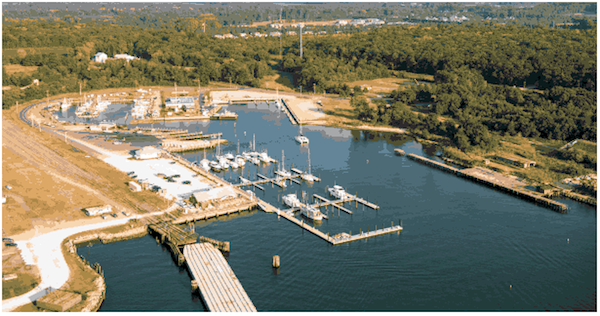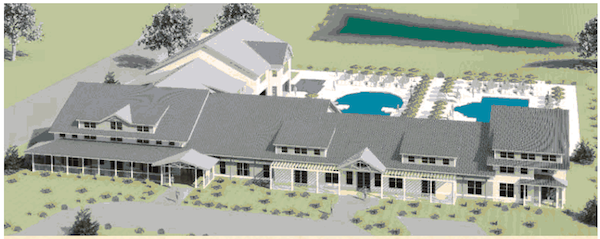Tour Showcases Beach Club, Future Yacht Center

In this view of Cape Charles Town Harbor, the new Yacht Center will utilize the rectangular cutout at middle back of photo.
CAPE CHARLES WAVE
September 21, 2013
New Northampton County development was showcased to County and town officials yesterday in an all-day tour that began at the new Bay Creek Beach Club.
Although there is not yet a great deal to see, the tour also took local officials to the site of the Cape Charles Yacht Center next to the Coast Guard Station.
The tour was organized by Eyre Baldwin, a partner in ESLAND (Eastern Shore Land Company), as well as being chief developer of the yacht center.
According to an ESLAND press release, the yacht center will be a mega-yacht destination along the East Coast. It will be accessed via the Town Harbor, which features an 18-foot deep channel for easy access. The full-service shipyard will be able to accommodate boats of “all sizes,” including mega-yachts.
Baldwin said the Yacht Center will attract visitors to the Town and will help to continue the revitalization of the area’s economy. “This development will bring new business opportunities such as restaurants, hotels and marine industries,” he said.
Officials visited the Beach Club and Fitness Center at Bay Creek, opening later this year as a members-only facility. The 19,000-square-foot complex includes a fitness center, a 2,800-square-foot members’ lounge with fireplace and large-screen TV, and two outdoor pools with a splash zone and aquatic play area for kids.

The members-only Bay Creek Beach Club and Fitness Center is planned to open in December.
CONTINUED FROM FIRST PAGE
Bay Creek is also beginning development of more-affordable housing known as The Cottages at Cassatt Green in Bayside Village. The first cottage is a model for the remaining nine that will be built on Cassatt Green. Design of the 2,000 square-foot houses incorporates the lines of coastal Victorian homes, with wide front porches looking out on a lush landscape and plantings native to the Eastern Shore. Prices start in the high $300s, and the homes can accommodate three to four bedrooms.
Officials then were bused to Mimosa Farm, on Baldwin’s property, for lunch, followed by a visit to Baldwin’s new development at Oyster where they were treated to a cocktail cruise and cookout.
Baldwin wants to “preserve the authenticity of Oyster and build upon its rich history” with low-impact development including eco-tourism, aqua-farming, kayak tours, fly fishing, hunting, and visitor accommodations.
“Our goal is to preserve, protect, and revitalize the Eastern Shore,” Baldwin said. “We have development initiatives that will create jobs and bring business to Northampton County. We believe that the best businesses are those that complement the Shore’s natural assets. Our future lies in stimulating maritime services, aquaculture, agriculture, eco-tourism and transportation/logistics.”

Development plans for Cape Charles include an industrial access road running from Stone Road to Bayshore Concrete.




















I enjoyed myself on this day very much. I also had four guests accompany me from Shore Stay Suites. They were very impressed; so much so that one couple will be relocating here from PA.
Thank you Mr. Baldwin for a wonderful day and “my” first boat ride.
Alice LaCroix
Manager
Shore Stay Suites
Hats off to the Baldwins for showing leadership for real economic development that is focused on our town and not the highway. Perhaps our Board of Supervisors will take notice and abandon their foolish plans to build the sewer pipline on the backs of the landowners on Route 13. If the federal and state governments want this sewer system then let them pay for it. We are an economically challenged county — one of the poorest in the state and one with the smallest population. Is the current BOS strategy to tax the common people so they sell their property at fire sale prices? Where does our state representative stand on this issue?
Boatyard maintenance work like pressure washing, sanding, painting have long been culprits tied to the release of heavy metals (copper, lead and zinc), along with non-joyful amounts of fiberglass and detergents into the Bay and nearby creeks. The prime pollutant of choice that is used to ensure boatyard profitability is bottom paint, which contains high levels of copper and zinc. Pick a yard, and water samples of boatyard runoff will always contain copper and zinc at hot zone levels. Copper and zinc are toxic to a number of aquatic organisms in our marshes and estuaries, and even at low concentrations, contribute to the formation of toxic hot spots. Dissolved copper has been found to affect the olfactory system of birds, mammals, and especially predator fish species (such as rockfish). This reduces the sense of smell, severely affecting homing and foraging. These impacts reduce the chances of survival or reproduction of fish species that migrate through Bay.
The Federal Clean Water Act requires industrial facilities, including boatyards, to employ low-technology, cost-effective “non-structural” techniques to control pollution discharges. The question is, who’s minding the store? Too late to stop, we can at least minimize the damage by keeping their feet to the fire with preventative maintenance, spill response plans and safe hazardous material and a few waste handling practices:
Pressure washing and sanding should occur in designated and contained areas away from water, so that any pollutants released will not run off of the site.
Vacuum sanders also help control the spread of pollution and allow for appropriate disposal of the resulting dust.
Hard-surface work areas should be regularly vacuumed to avoid tracking pollutants throughout the site.
Outside work should not occur during high winds or rain that increase the chance of spreading pollution to nearby waterways.
Wastewater from boatyards should be kept separate from storm water runoff, so that contaminated wastewater is not discharged to storm drains or nearby creeks. Wastewater should be recycled or discharged to a sanitary sewer, where it will be appropriately treated at the Cape Charles wastewater treatment plant.
Structural changes, such as installing an advanced filtration system, may also be required depending on how bad they will be at controlling pollution discharges.
And you thought a little brown water being discharged into the harbor was a disaster? You ain’t seen nothing yet.
Excellent points raised by Mr. Creed. If history is any judge, and if we are not careful, it will be “business as usual” here on the Shore with regards to enforcing safety and environmental hazard abatement. This is a golden opportunity to create a truly state of the art “green and clean” boat maintenance facility that should not be squandered.